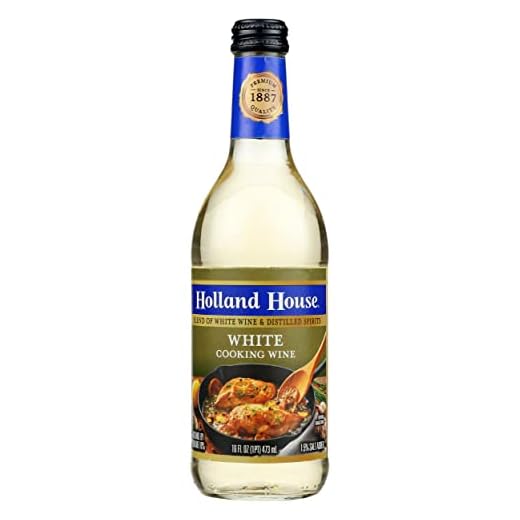



For those moments when a recipe calls for a particular fermented grape beverage, consider using a splash of broth or stock. This option not only adds depth but also retains the dish’s moisture without altering its intended flavor profile.
If you seek acidity, a drizzle of lemon juice can provide the necessary brightness. Its tartness mimics the crisp notes found in many fermented beverages, enhancing the overall taste of your dish.
Another excellent substitute is apple cider vinegar. Its fruity undertones can complement a variety of ingredients while offering that sought-after tang. Just remember to use it sparingly, as its potency can easily overwhelm your creation.
For a touch of sweetness, try using white grape juice. This option works particularly well in sauces and marinades, lending a gentle sweetness that can balance savory components beautifully.
Lastly, consider using coconut milk for creaminess in certain dishes. This can be especially delightful in curries and tropical recipes, where a rich, velvety texture enhances the overall experience.
Alternatives for Cooking with White Wine
For those seeking options in place of traditional white wine, consider these flavorful substitutes:
- Chicken or Vegetable Broth: A savory base that adds depth to dishes, providing moisture and enhancing flavors.
- Apple Cider Vinegar: Offers a fruity acidity, ideal for marinades and salad dressings. Dilute with water to soften the sharpness.
- Lemon Juice: Brightens dishes with its zesty profile; perfect for seafood and poultry recipes. Use sparingly to avoid overpowering other flavors.
- White Grape Juice: A sweet alternative that can mimic the fruity notes of white wine. Blend with a splash of vinegar for balance.
- Sparkling Water: Adds a light fizz and moisture; great for deglazing pans and enhancing sauces without adding alcohol.
Experiment with these options based on the dish and desired flavor profile. Adjust quantities to taste for the best results.
Understanding the Role of White Wine in Recipes
In many dishes, this ingredient contributes acidity, enhancing flavors and balancing richness. When added during the cooking process, it helps to deglaze pans, lifting the fond and integrating those roasted bits into the sauce. This not only deepens the flavor but also adds complexity to the final dish.
Furthermore, the evaporation of alcohol during preparation allows for the retention of the essence, leaving behind the bright notes that elevate the overall experience. The combination of acidity and aromatic properties can brighten heavy preparations and enrich lighter fare.
For seafood and poultry, this liquid complements delicate flavors, creating a harmonious blend. In sauces, it acts as a foundation, providing depth and enhancing the profile of the primary ingredients. The right choice can mimic these qualities, ensuring the dish remains balanced and flavorful.
Understanding the contribution of this ingredient enables you to identify suitable alternatives that maintain the integrity of your recipes while allowing for creativity and personal flair in your culinary endeavors.
Best Non-Alcoholic Substitutes for White Wine
Apple cider vinegar stands out as a fantastic alternative. Dilute it with an equal part of water to mimic the acidity and brightness typical of a vintage. This combination works well in marinades and sauces.
Citrus juices, particularly lemon and lime, offer a refreshing punch. Use fresh juice, as it provides the acidity needed to balance flavors in dishes like risottos and seafood recipes.
For a more complex flavor profile, consider using non-alcoholic sparkling grape juice. It adds sweetness and effervescence, making it suitable for braising meats or deglazing pans.
Broths can also play a pivotal role. Chicken, vegetable, or fish stock infused with a splash of vinegar can replicate the savory depth found in many recipes that call for fermented beverages.
Below is a comparison of various non-alcoholic alternatives:
| Substitute | Ratio | Best Uses |
|---|---|---|
| Apple Cider Vinegar | 1:1 with water | Marinades, sauces |
| Citrus Juice | Freshly squeezed | Seafood dishes, risottos |
| Sparkling Grape Juice | 1:1 | Deglazing, braising |
| Broth (Chicken/Vegetable/Fish) | 1:1 | Soups, stews, sauces |
Experiment with these options to achieve desired flavors without the alcohol. Each substitute can enhance the dish while maintaining its integrity.
Using Vinegars as a White Wine Alternative
For dishes needing acidity and depth, vinegars can serve as excellent substitutes. Balsamic vinegar, with its sweetness and complexity, enhances sauces and marinades. A splash can elevate roasted vegetables or glazes, providing a rich flavor profile.
Apple cider vinegar brings a fruity tang that complements poultry and seafood. Diluting it with water or broth can balance its sharpness while maintaining the necessary acidity.
Rice vinegar, particularly the seasoned variety, pairs well with Asian cuisines, brightening stir-fries and dressings. Its mild flavor makes it a versatile option for various recipes.
For a more intense flavor, consider using sherry vinegar. Its nutty and slightly sweet notes can enhance soups and stews, creating a layered taste experience.
Lastly, white wine vinegar is a straightforward 1:1 replacement. Its similar acidity and flavor profile make it suitable for most recipes, ensuring a seamless transition without compromising taste.
Fruit Juices That Mimic the Flavor of White Wine
Citrus juices can effectively replicate the acidity and brightness of a certain fermented beverage. Here are specific options to consider:
- Lemon Juice: Offers a sharp acidity. Use it sparingly to enhance dishes without overwhelming them.
- Lime Juice: Similar to lemon but with a unique zest. It works well in seafood and chicken recipes.
- Apple Juice: Provides a touch of sweetness along with acidity. Ideal for marinades and glazes.
- White Grape Juice: Closely resembles the flavor profile of its fermented counterpart. Use it as a 1:1 replacement in sauces and braises.
- Pineapple Juice: Adds sweetness and acidity, perfect for tropical-inspired dishes.
For enhanced flavor, consider diluting fruit juices with a bit of water or vinegar to mimic the complexity of a certain fermented beverage. For example, mixing white grape juice with a splash of vinegar can create a more balanced substitute.
When preparing roasted meats, such as turkey, fruit juices can add depth to the dish. For a detailed guide on roasting techniques, refer to how to cook a 9lb turkey breast in the oven.
Experimenting with these alternatives can open up new flavor dimensions in your culinary creations.
Impact of Different Broths as a Replacement
Chicken, vegetable, or fish stock can effectively enhance dishes that typically call for a certain fermented grape beverage. These liquids provide moisture and depth of flavor, making them a solid alternative in various recipes.
Chicken Broth
Rich and savory, chicken broth adds a comforting element to poultry and pasta dishes. It can mimic the acidity and slight sweetness of fermented grape beverages while enriching the overall flavor profile. When using chicken broth, consider adding a splash of lemon juice or a dash of vinegar to replicate the tangy notes often found in fermented options.
Vegetable Broth
For plant-based recipes, vegetable broth serves as an excellent substitute. It brings a subtle umami flavor, particularly when simmered with herbs and spices. To achieve a more complex taste, infuse the broth with aromatics like garlic, onions, or bay leaves. Enhancing vegetable broth with a bit of citrus juice can also elevate the dish and provide a refreshing brightness.
Fish stock, while less common, can add a unique character to seafood preparations. Its delicate flavor complements shellfish and white fish, ensuring that the dish remains balanced and flavorful. Adjusting the seasoning with a hint of acidity or herbs can further enhance the final result.
Combining Ingredients for the Best Flavor Profile
Balance is key when crafting dishes without fermented grapes. Start with acid and sweetness: citrus juices like lemon or lime can brighten flavors, while apple or pear juice lends a touch of sweetness. For depth, consider using broth, which adds umami and richness. Combine vegetable stock with a splash of vinegar for complexity.
Herbs play a significant role in enhancing the taste. Fresh herbs like parsley, basil, or thyme can elevate the overall profile. Pairing these with garlic and shallots provides a robust foundation. Always taste as you go; layering flavors creates harmony. Adjust salt, acidity, and sweetness accordingly, ensuring no single element overpowers the others.
Experimenting with Flavors
Textures matter too. For creamy dishes, coconut milk or dairy alternatives can mimic the richness typically brought by alcohol. In contrast, for lighter fare, consider incorporating a splash of soda or tonic water to add effervescence and brightness.
Don’t shy away from blending unconventional ingredients. A hint of mustard or a dash of soy sauce can introduce intriguing flavor notes. The goal is to create a balanced, layered dish that excites the palate while honoring the original recipe’s intent.







